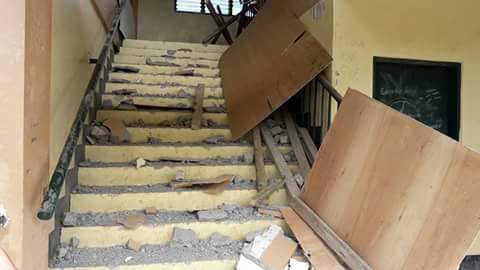Houses damaged as strong earthquake hits southern PH

A structure is damaged following a magnitude 6 earthquake that struck Lanao del Sur Wednesday. PHOTO CONTRIBUTED BY SHORAIDA ABANTAS-AMPATUA VIA RADYO INQUIRER
A strong magnitude 6.0-earthquake hit the southern Philippines at dawn on Wednesday, damaging dozens of houses and sending people fleeing into the streets for safety, authorities said.
Schools and government buildings were also damaged.
There were no immediate reports of serious casualties but electricity was cut and water pipes ruptured in Lanao del Sur, a mainly rural region some 800 kilometers (500 miles) south of Manila, they said.
The quake struck at 5:21 a.m. sending residents jumping out of bed and running onto the road to avoid falling objects, disaster officials said.
READ: Magnitude 6 quake jolts Lanao del Sur-Bukidnon area
Article continues after this advertisement“Residents are really shocked with regard to the calamity that happened. So they are on standby (at) the highway,” provincial disaster official Francis Garcia said over ABS-CBN television.
Article continues after this advertisementPatients were evacuated outside a district hospital as a precaution, Garcia added.
The Philippine Institute of Volcanology and Seismology (Phivolcs) said the quake was felt in 16 other cities and towns in the south including the major urban centers of Davao and Cagayan de Oro.
Francis Magbanua, an ABS-CBN reporter based in the south, tweeted a photo of a television set on the floor that he said had fallen off the wall of his house.
“Our appliances fell from the (wall) racks,” he said.
Crowdsourced photos from the site of the quake in Panang town showed cracked concrete walls of houses and offices, collapsed wooden ceilings, and even fractured roads.
TINGNAN: Epekto ng magnitude 6.0 na lindol sa Wao, Lanao del Sur.
C/o Shoraida Abantas-Ampatua, location: Panang National High School. pic.twitter.com/h0vIPgKUIU— RadyoInquirer990AM (@dzIQ990) April 12, 2017
TINGNAn: Epekto ng magnitude 6.0 na lindol sa Wao, Lanao del Sur. C/o Shoraida Abantas-Ampatua. pic.twitter.com/X6sQaCGa9f
— RadyoInquirer990AM (@dzIQ990) April 12, 2017
Phivolcs said a highway had a crack while wooden houses, a national high school and a mosque sustained minor damage.
The tremor came days after a trio of strong earthquakes damaged buildings and caused panicked tourists to flee Mabini, Batangasa resort town south of Manila famous for its marine life and coral reefs.
READ: Earthquake swarm hits Batangas
“Since the (Mabini) quake, our people became more aware to duck, (take) cover and hold,” Kristofferson Vidad, science research assistant at the seismology agency, told Agence France-Presse, referring to its standard advice on surviving quakes.
The Philippines lies on the Pacific “Ring of Fire” where tectonic plates collide, causing frequent earthquakes and volcanic activity.
A 6.5-magnitude quake killed eight people and left more than 250 injured outside the southern city of Surigao in February, and another 5.9-magnitude tremor killed one person there last month.
Before the Surigao quakes, the last lethal earthquake to hit the country was a 7.1-magnitude tremor that left more than 220 people dead and destroyed historic churches when it struck Cebu and Bohol in October 2013. With a report from Yuji Vincent Gonzales/INQUIRER.net